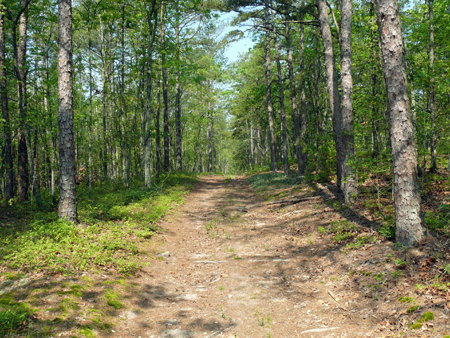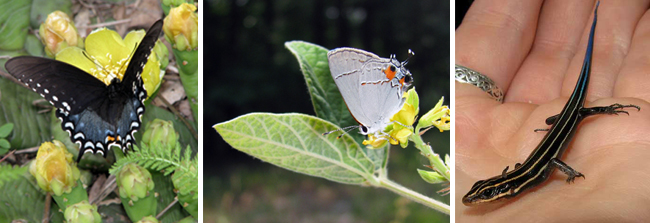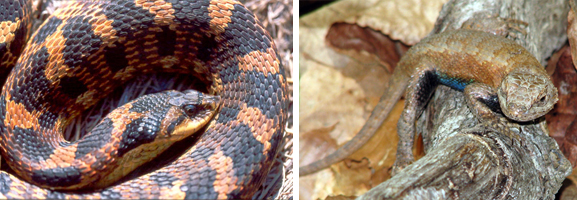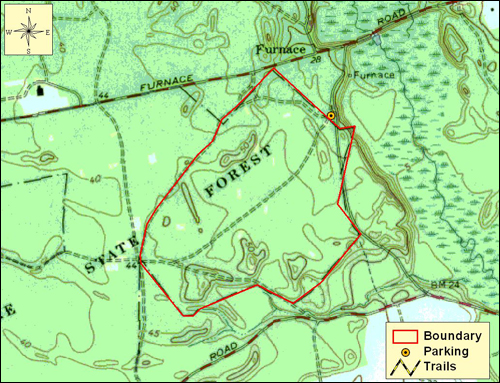Furnace, Worcester County
 Furnace Natural Area, named for a local colonial-era iron furnace, is a large upland forest composed of very dry, sandy soils and ancient sand dunes. Thousands of years ago, these sand dunes were formed by wind and erosion. Today, visitors can still view the ancient dunes as well as one of the best examples of shortleaf pine forest communities found in Maryland. The high quality forest, composed of pines and hickories, supports at least nine rare, threatened, or endangered species, various songbirds, and an abundance of native snakes and lizards. Long ago, wild fires randomly burned large swaths of forest and created a mosaic of openings. Today, small openings are maintained to provide habitat for rare species that need open, sunny spots to grow within this special shortleaf pine forest. Within these openings, visitors can see Maryland's only native cactus, the prickly pear, as well as the Threatened hairy snoutbean (Rhynchosia tomentosa).
Furnace Natural Area, named for a local colonial-era iron furnace, is a large upland forest composed of very dry, sandy soils and ancient sand dunes. Thousands of years ago, these sand dunes were formed by wind and erosion. Today, visitors can still view the ancient dunes as well as one of the best examples of shortleaf pine forest communities found in Maryland. The high quality forest, composed of pines and hickories, supports at least nine rare, threatened, or endangered species, various songbirds, and an abundance of native snakes and lizards. Long ago, wild fires randomly burned large swaths of forest and created a mosaic of openings. Today, small openings are maintained to provide habitat for rare species that need open, sunny spots to grow within this special shortleaf pine forest. Within these openings, visitors can see Maryland's only native cactus, the prickly pear, as well as the Threatened hairy snoutbean (Rhynchosia tomentosa).

Furnace Natural Area lies within the Pocomoke River watershed. The sand dunes at Furnace are believed to have formed 13,000 to 30,000 years ago, sculpted by winds at the end of the Pleistocene Epoch. The dunes formed from the underlying Parsonsburg Sand Formation which covers much of the lower Delmarva Peninsula. Many dunes retain the crescent or parabolic shapes that serve as clues to their origin. This 230 acre Natural Area is owned by the State of Maryland and is managed as a component of the Pocomoke State Forest.

Trees of Change
Some of the forest stands within this Natural Area have been replanted in pure loblolly pine. Though this species is native to Maryland, it never would have been found in such abundance in upland areas without being planted. Over time, a more natural mix of shortleaf pine, oak and hickory should naturally replace the loblolly pine
A Fiery Past
 Before Europeans settled this region, fire was a major force that shaped coastal areas of Maryland. Europeans suppressed wild fires, altering pressures affecting natural communities. Before fire suppression, the landscape in places like Furnace likely would have contained more open areas dominated by grasses and flowers such as the rare spurred butterfly-pea (Centrosema virginiana). Despite the lack of fire, Furnace is still very diverse compared to many other forests in the area.
Before Europeans settled this region, fire was a major force that shaped coastal areas of Maryland. Europeans suppressed wild fires, altering pressures affecting natural communities. Before fire suppression, the landscape in places like Furnace likely would have contained more open areas dominated by grasses and flowers such as the rare spurred butterfly-pea (Centrosema virginiana). Despite the lack of fire, Furnace is still very diverse compared to many other forests in the area.
Click here for a Print Version of this map.

Directions
From Salisbury Take US 13 to MD 12 south and continue 11 miles to Old Furnace Road. Take a right onto Old Furnace Road to the intersection with Millville Road (about 1.8 miles). Make a left onto Millville Road and follow it for about 0.2 miles. There will be a dirt lane and a small parking area. The parking area is just south of the Furnace Town Outdoor Living Museum.


Driving directions and aerial views open with Google Maps. For the aerial view button, if an aerial view does not open by default, click on the Satellite icon in the upper right corner and Google Maps will switch to an aerial view of the Natural Area.

Acknowledgments
Scenic View of Furnance Natural Area. Photo by: Wes Knapp
Wildlife Collage One: (left to right)
A spicebush swallowtail feeds on the nectar of a prickly pear blossom. Prickly pears grow very well in dry, sandy soil. Photo by: Kerry Wixted
A gray hairstreak visits the flowers of a hairy snoutbean. These plants readily grow in nutrient-poor environments. Photo by: Kerry Wixted
A juvenile common five-lined skink is care-fully handled by a biologist. Young skinks have very clear stripes and bright blue tails. �As they age, females' tails may turn bluish-gray but males' tails �will turn a dull brown. Photo by: Kerry Wixted
Wildlife Collage Two: (left to right)
The harmless eastern hog-nosed snake is named for its upturned snout, resembling a hog's nose. They are efficient burrowers and specialize in preying on toads. These snakes are known for their act of playing dead when they feel threatened. Photo by: Scott Smith
Look for eastern fence lizards sunning them-selves on fallen logs and rock piles along the forest edges. Fence lizards are usually brownish gray in color. During breeding season, however, the males will develop bright blue patches �on their throat and underside. Photo by: Kerry wixted
Spurred butterfly-pea blooms in late August and September. Photo by: Hans Hillewaert/Wikimedia Commons